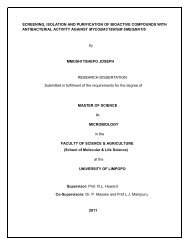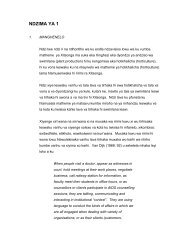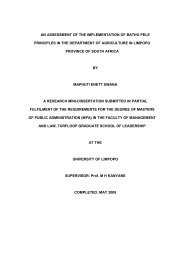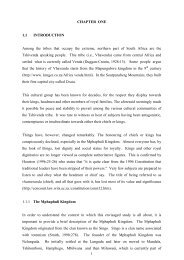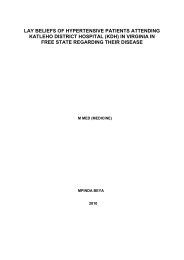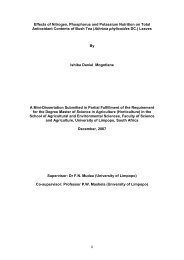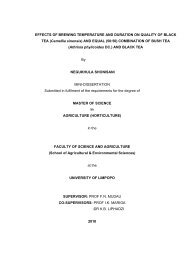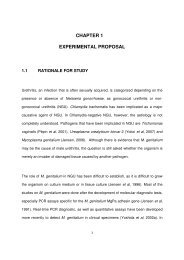Thesis submitted 23-03-2012.pdf - University of Limpopo ...
Thesis submitted 23-03-2012.pdf - University of Limpopo ...
Thesis submitted 23-03-2012.pdf - University of Limpopo ...
Create successful ePaper yourself
Turn your PDF publications into a flip-book with our unique Google optimized e-Paper software.
3.4.3 The fate <strong>of</strong> nanoparticles after administration into the body<br />
The distribution <strong>of</strong> nanoparticles and their loads throughout the body<br />
depends on numerous physicochemical factors: size <strong>of</strong> particles, toxicity,<br />
surface charge, capacity for protein adsorption, surface hydrophobicity,<br />
drug loading and release kinetics, stability, degeneration <strong>of</strong> carrier system,<br />
hydration behavior, electrophoretic mobility, porosity, specific<br />
characteristics, density, crystallinity, contact angle, and molecular<br />
weight. 245 Nevertheless, the fate and consequently the possible toxicity <strong>of</strong><br />
magnetic nanoparticles also depends strongly on the dose and<br />
administration route.<br />
After particles are injected into the blood sream,they are conditioned or<br />
coated by elements like plasma proteins and glycoproteins available in the<br />
circulatory system. This process is called opsonization. The process<br />
makes the nanoparticles recognizable by the major defense system <strong>of</strong> the<br />
body like the macrophages (mainly kupffer cells in the liver) and other<br />
macrophages remove these opsonized particles. Particles having<br />
hydrophobic surface are more efficiently coated, but those having<br />
hydrophilic surface resist coating and are therefore cleared more slowly<br />
from the body. The macrophages take the particles to the endosomes and<br />
lysosomes where they are degraded, so that the drug the particle is<br />
carrying is released and diffused to the circulatory system. The particles<br />
are later excreted from the body or processed further by the body for other<br />
possible metabolic activities.<br />
Where uptake <strong>of</strong> particles by macrophages may be a hinderance in drug<br />
delivery to target area, the particles may be disguised, so that they are not<br />
recognized by the kupffer cells and therefore escape capture by the cells.<br />
The nanoparticles may be disguised partly by making them hydrophilic<br />
(depending on the type <strong>of</strong> treatment) and by stabilizing them using<br />
absorbed polymers which did not allow recognition <strong>of</strong> liposome by<br />
macrophages and thus prevent opsonization. 255<br />
129



